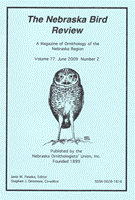Nebraska Ornithologists' Union

Nebraska Bird Review
A Preliminary Survey of Southeast Nebraska Grassland Habitat and Potential Henslow’s Sparrow Habitat
Date of this Version
6-2007
Document Type
Article
Citation
Silcock, “A Preliminary Survey of Southeast Nebraska Grassland Habitat and Potential Henslow’s Sparrow Habitat,” from Nebraska Bird Review (June 2007) 75(2).
Abstract
INTRODUCTION
The decline in numbers of Henslow’s Sparrows in North America (Sauer et al. 2001) is generally considered to be due to reduction in the extent of its preferred breeding habitat, “relatively large fields consisting of tall, dense grass, a well-developed litter layer, standing dead vegetation, and sparse or no woody vegetation” (Herkert et al. 2002). Since 1985, however, the Conservation Reserve Program (CRP) has allowed payments to landowners by the United States Department of Agriculture (USDA) through the Farm Service Agency (FSA) to idle croplands and to seed them to various grasses. This has provided habitat that appears to have stabilized Henslow's Sparrow numbers in some parts of the breeding range (Herkert 1997; Herkert et al. 2002; Reinking 2002; McCoy 2000). Nebraska has 472,000 hectares (l,166,000 acres) of CRP grassland, about four times more than the remaining area of tallgrass prairie (Steinauer and Collins 1996), but most is aging, unmanaged, and less attractive to most grassland birds (Negus 2005).
To better understand the occurrence of Henslow's Sparrow in Nebraska, we surveyed grasslands south and east of Lincoln from May to August 2006. The survey goals were to search for grassland sites that might provide suitable nesting habitat, count Henslow's Sparrows at each site, and use point counts to estimate abundance of Henslow's Sparrows in this region.


Comments
Copyright 2007 Nebraska Ornithologists’ Union. Used by permission.